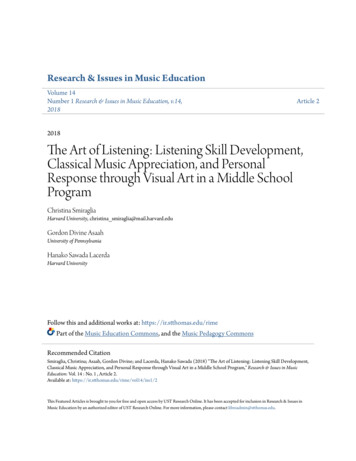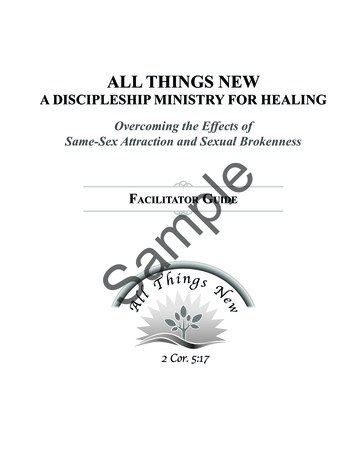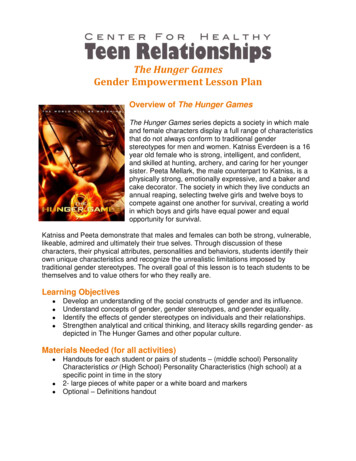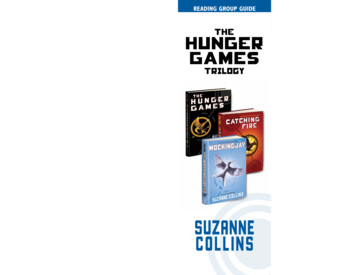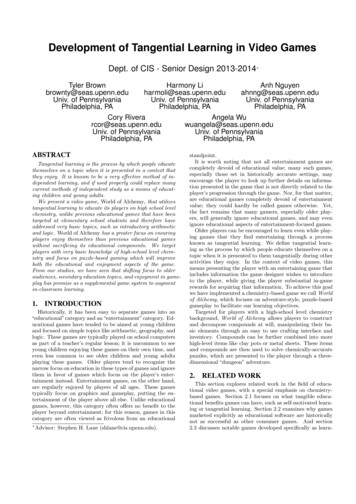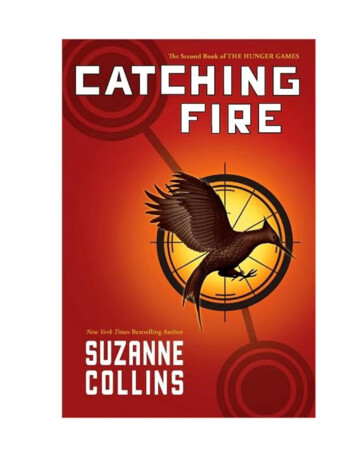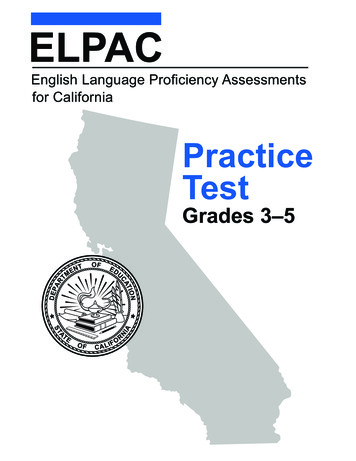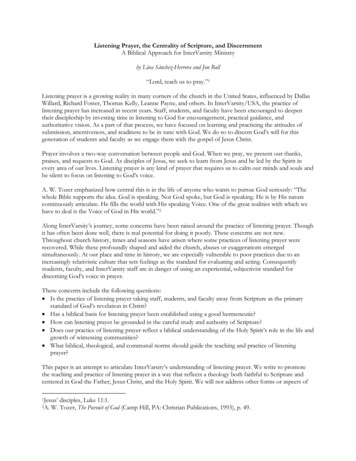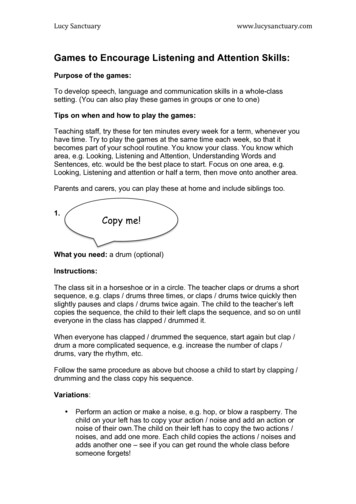
Transcription
Lucy Sanctuarywww.lucysanctuary.comGames to Encourage Listening and Attention Skills:Purpose of the games:To develop speech, language and communication skills in a whole-classsetting. (You can also play these games in groups or one to one)Tips on when and how to play the games:Teaching staff, try these for ten minutes every week for a term, whenever youhave time. Try to play the games at the same time each week, so that itbecomes part of your school routine. You know your class. You know whicharea, e.g. Looking, Listening and Attention, Understanding Words andSentences, etc. would be the best place to start. Focus on one area, e.g.Looking, Listening and attention or half a term, then move onto another area.Parents and carers, you can play these at home and include siblings too.1.Copy me!What you need: a drum (optional)Instructions:The class sit in a horseshoe or in a circle. The teacher claps or drums a shortsequence, e.g. claps / drums three times, or claps / drums twice quickly thenslightly pauses and claps / drums twice again. The child to the teacher’s leftcopies the sequence, the child to their left claps the sequence, and so on untileveryone in the class has clapped / drummed it.When everyone has clapped / drummed the sequence, start again but clap /drum a more complicated sequence, e.g. increase the number of claps /drums, vary the rhythm, etc.Follow the same procedure as above but choose a child to start by clapping /drumming and the class copy his sequence.Variations: Perform an action or make a noise, e.g. hop, or blow a raspberry. Thechild on your left has to copy your action / noise and add an action ornoise of their own.The child on their left has to copy the two actions /noises, and add one more. Each child copies the actions / noises andadds another one – see if you can get round the whole class beforesomeone forgets!
Lucy Sanctuary 2.www.lucysanctuary.comPerform a sequence of actions or noises, e.g. touch your head, turnabout, touch the floor; clap, stamp your feet, blow a raspberry. Whenyou say “Go!” the children copy you.Go!What you need: a list of instructions (see example instructions – you knowthe children so you can make them harder or easier).Instructions:The class sit in a horseshoe or a circle so that you can see everyone. Explain:“Listen carefully. I am going to tell you to do something. For example, jump!Turn around! Don’t do it, until I say GO!”Get the class to stand up. Read the instruction and leave a short pause beforeyou say GO!To make this harder: leave a longer gap before you say GO!Suggestion: Chose children to think an instruction and say GOExample Instructions1. Stand up. Go!2. Pat your head. Go!3. Close your eyes. Go!4. Stick your tongue out. Go!5. Rub your tummy. Go!6. Hop. Go!7. Clap twice. Go!8. Turn around. Go!9. Shake hands with the person next to you. Go!10. Pull a silly face. Go!11. Close your eyes and hop. Go!12. Pat your head and touch the floor. Go!3.Fruit Salad!What you need: (Optional) pictures of fruit.
Lucy Sanctuarywww.lucysanctuary.comInstructions:The class sit in a horseshoe or a circle so that you can see everyone. Put thefruit on the board (four or five types of fruit, e.g. bananas, apples, pears,grapes, peaches) Go round the class touching each child’s head and tellingthem what fruit they are, e.g. “You are banana. You are apple. You are pear.You are grape. You are peach. You are banana .”. Check they canremember what fruit they are (e.g. Put your hand up if you are a pear, etc.)When you say a fruit, e.g. banana, all the children that are bananas have toswap places. After a few turns, sit down when the children are changingplaces so that a child is left without a seat. That child then calls out a fruit andtries to make sure that he gets a seat so that another child has to call out thefruit!Suggestion: Call out something that most definitely will not be in a fruit salad fromtime to time, e.g. a sock, a worm!Play this game with speech sounds (phonemes not graphemes), e.g.“You are s, you are k, you are sh, you are b .” When you say aspeech sound, e.g. “sh”, all the children that are sh, swap places.Thumbs up!Thumbs down!4.What you need: List of true and false statements, e.g. “I’ve got blue hair.Thumbs up or thumbs down?!” “Spiders have eight legs. Thumbs up orthumbs down?!” (See example statements)Instructions:The class sit in a horseshoe or a circle so that you can see everyone. Geteveryone to give you a thumbs up or a thumbs down. Tell the class you aregoing to tell them something. They have to listen carefully. If they think it istrue, they give you a thumbs up. If they think it isn’t true, they give you athumbs down. (Practise first as they can find thumbs up/down hard).Example Statements1.2.3.4.5.6.7.Milk is purple.It is very hot at the North Pole.Spiders have eight legs.Apples grow on trees.Spaghetti grows on trees.Cats bark.A bicycle is faster than a car.
Lucy Sanctuary8.9.10.11.12.www.lucysanctuary.comA train is faster than a bicycle.An ant is smaller than a butterfly.Christmas is in August.You need helmets to play tennis.I’ve got orange eyes.Suggestion: Make statements about curriculum topics, e.g.Romans:1. The Romans invented showers.2. Romans wore togas, etc.Numeracy:1. All the sides of a rectangle are equal.2. A cube is a 2D shape.3. An octagon has six sides. etc.When the class are familiar with this activity, get them to make five true orfalse sentences in pairs or small groups.5.Hurrah-Boo!What you need: List of hurrah-boo statements (nice and not so nicesentences!), e.g. “We’re going to the cinema!” “There’s no playtime today!”(See example statements)Instructions:The class sit in a horseshoe or a circle so that you can see everyone. Practisesaying “Hurrah!” and “Boo!” Tell the class that you are going to tell themsomething – if they like it, they have to say “Hurrah!” and if they don’t like itthey have to say “Boo!”Example StatementsChristmas has been cancelled!We’re going to do maths all afternoon!School is cancelled next week!We are going to watch tv all day tomorrow!We will have sweets for lunch!It is going to snow tomorrow!The Queen is coming to our school tomorrow!We are getting a dog for the class!
Lucy Sanctuarywww.lucysanctuary.comWe are going to the zoo tomorrow!We are having monkey’s brains for lunch!We are going to clean the classroom all day tomorrow!We are going swimming after lunch!One Direction are coming to school this afternoon!Listen andJump!6.What you need: List of statements, e.g. “If you have got trousers on, jump!”(See example statements)Instructions:The class sit in a horseshoe or a circle so that you can see everyone. Give acommand involving an action that the children have to do. For example, “Ifyou have blue eyes, jump!” “If you have a sister, jump!”Suggestion: Children can think of two or three commands in small groups orpairs. They can give the commands to the class.Example Commands:If you have curly hair, jump!If you have short hair, jump!If you have long hair, jump!If you have black hair, jump!If you have red hair, jump!If you have blonde hair, jump!If you have brown hair, jump!If you are wearing black shoes, jump!If you have brown eyes, jump!If you have blue eyes, jump!If you have green eyes, jump!If you are wearing a skirt, jump!If you are wearing trousers, jump!If you have a sister, jump!If you have a brother, jump!If you have a pet, jump!If you have a dog, jump!If you have a cat, jump!Suggestion: Make statements about curriculum work, e.g.Science: If you think that the nearest planet to Earth is Mars, jump! Ifyou think that humans could live on the moon, jump! Etc.
Lucy Sanctuarywww.lucysanctuary.comLiteracy: If you can spell because, jump! If you can spell people, jump!If you know what letter comes after f in the alphabet, jump! Etc.Squashedbananas!7.What you need: List of questions, e.g. “What do you brush your teeth with?!”(See example questions)Instructions:The class sit in a horseshoe or a circle so that you can see everyone. Choosea child to sit in front of the class. Ask the child a question. They have toanswer, but they can only say “Squashed bananas” and they must NOTlaugh! If the child laughs, they are out.Tips: Get the class to think of, and ask questions.Have a class champion!QuestionsWhat’s your name?What would you say to the Queen ifshe came to tea?Where do you live?What is in your bag?What do you clean your teeth with?What is in your pockets?What do you wash with?What is your favourite ice cream?What do you brush your hair with?What do you write with?What does your best friend look like?What are you going to give to yourmum for Christmas?What do you want for your birthday?Who do you like to dance with?What do you like wearing?What do you play football with?
Lucy Sanctuarywww.lucysanctuary.comWhat do you clean the house with?What are you sitting on?If you won a million pounds, whatwould you buy?What are you wearing?8.Who’s missing?What you need: N/AInstructions:The class sit in a horseshoe or a circle so that you can see everyone. Tell theclass to look around the horseshoe like detectives! Tell them to look at who iswhere . Then tell them all to close their eyes. Choose a child and tapthem on the shoulder. The child quietly gets up and leaves the room. Tell thechildren to open their eyes, look around and put their hand up if they knowwho is missing.Suggestion: Increase the number of children that you tap on the shoulder toincrease the memory load.9.Build it!What you need: Wooden building bricks or duplo blocks.Instructions:The class sit in a horseshoe or a circle so that you can see everyone. Put thebricks on the floor in front of the class. Place a brick on the floor to start thetower. When you say a child’s name, they come and put a brick on the toweruntil it falls down!Variations: Children put a brick on the tower when you look at them.
Lucy Sanctuarywww.lucysanctuary.comTell it!10.What you need: an envelope or a bag with the titles of well known stories ornursery rhymes in it, e.g. Sleeping Beauty, The Hungry Caterpillar, The ThreeBilly Goats Gruff, The Tiger who came to Tea, Humpty Dumpty, The Duke ofYork, etc.Instructions:The class sit in a horseshoe or a circle so that you can see everyone. Take atitle from the envelope and read it to class, e.g. Cinderella. Start telling thestory. Choose a child to continue the story. After a short time, choose anotherchild to continue telling the story, and so on until the class have told the wholestory.Variations: The child choses the next child to continue telling the story.Make up a story with the class and take it in turns to tell parts of it.Have an object bag. Each child takes an object and they have toinclude this in the story. 11.Magic sound!What you need: (optional) pen and paperInstructions:Either sit the children at tables with pen and paper or the class sit in ahorseshoe. Introduce a magic sound, e.g. s. Every time the children hear yousay the magic sound, e.g. s, they have to stand up (clap/stamp their feet, etc.)or tick the piece of paper.This is easy: Count to at least five silently then say s. Do this at least fourtimes (leaving shorter or longer pauses depending on the group). Or hum atune for at least five seconds and then say s (humming increases theanticipation!)
Lucy Sanctuarywww.lucysanctuary.comThis is harder: say at least five other speech sounds before you say s. Forexample: b, t, k, w, d, s. Repeat this at least four times. It is harder for childrento hear s if you say similar speech sounds, e.g. f, sh, v, z.For example: Say the following sounds: b k d m p s w t g l ch s sh n hf b dg s p k t ch d sThis is even harder: Ask the children to listen for animals that start with s (orfood / clothes / names / transport, etc that start with s – use key words fromclass topics if you can) As above, say at least five words that start withdifferent speech sounds before you say one that starts with s, e.g. cat,donkey, duck, pig, dog, seagull. (This activity is harder if the words contain sin any word position, e.g. walrus (at the end of the word), ostrich (in themiddle).For example: Say: whale eel dolphin penguin seal chicken duck goosecuckoo turkey seagull worm ladybird bee snail donkey sheep horsecow dog squirrel12.Guess theinstrument!What you need: a selection of different musical instruments, e.g. bells,shaker, drum, whistle, etc.Instructions:Children sit in a horseshoe or at tables. Show the class at least threeinstruments (depending on their level). Play each one for the class. Ask theclass to close their eyes and play at least two.Choose a child to come and show you which instruments you played.To make this harder: increase the number of instruments you play.To make this easier: give each child an instrument. They place theinstrument on the floor or on the table if they are sitting at tables. They puttheir hands on their legs. When you say “Go!” They have to pick up theirinstrument and play it until you say “Stop!”Choose children to say Go and Stop!
Lucy Sanctuarywww.lucysanctuary.comOranges andLemons!13.What you need: Paper and pencils or crayons.Instructions:Children sit at tables. Divide the class into oranges and lemons. Give differentinstructions to the oranges and lemons, so they are not doing the same thing.See listed examples of instructions to use.Example Instructions Oranges, draw a house! Go! Lemons, draw a dog! Go!Oranges, draw a tree next to the house! Go! Lemons, draw a cat nextto the dog! Go! Oranges, draw the sun! Go! Lemons, draw a bicycle! Go! Oranges, draw two flowers! Go! Lemons, draw a cake! Go! Oranges, draw a bird! Go! Lemons, draw a cup of tea! Go!14.That’s wrong!What you need: an envelope or a bag with the titles of well known nurseryrhymes in it, e.g. Jack and Jill, Twinkle Twinkle Little Star, Baa Baa BlackSheep.Instructions:Children sit in a horseshoe. Take the title of a nursery rhyme out of the bag.Tell the class that you are really good at saying nursery rhymes. Tell themthat if they hear any problems, they can stop you, but they won’t because youare amazing at nursery rhymes!Make errors in the nursery rhymes as you tell them. For example: “Baa, baablue sheep” The children correct you, e.g. “No! Baa, baa black sheep!” Ask ifyou can try again, e.g. “Oh sorry! I thought it was blue sheep. Can I try again?Thanks. I will be fine now. Baa, baa black sheep have you any wool? Yes, Sir.Yes, Sir. Five bags full” and so on!
Lucy Sanctuarywww.lucysanctuary.comFor example: Baa baa pink sheep, have you any bananas, yes sir yes sir 500bags full, one for the elephant, one for the crocodile, and one for the grannywho lives down the lane.Variations: Tell well-known stories and make errors in your telling.15.Make a card!What you need: Paper or card, coloured crayons, pens or pencils, decorativematerials, e.g. sequins, glitter, feathers, etc.Instructions:Children sit at tables. Tell them they are going to make a card. They have tolisten carefully and do what you tell them to do. Pause between instructionsso they have time to follow your direction. Fold your paper/card in half.Draw a big flower on the front.Colour the petals red or orange.Choose four sequins from the box. Stick one sequin on each petal.Open up the card. Choose a piece of tissue paper from the box.Cut the tissue paper into a big heart.Stick the heart on the right hand page.Write To Mum at the top of the page.Write love from and your name at the bottom.Suggestion: Give each child two pieces of card, e.g. a green piece and a redpiece, or two faces, e.g. a happy face and a confused face. Tell them that ifthey are not sure what they have to do, they can hold up the red piece of card(or the confused face) and you will come and help them.16.Action!What you need: pencils and paper, enclosed texts or sections from classreading books, curriculum texts, well known stories, etc.Instructions:Children sit at tables. They listen to the text and put a tick on their piece ofpaper every time they hear a doing word (verb). For example, He jumpeddown onto the grass, and ran across the field. Read the text twice.
Lucy Sanctuarywww.lucysanctuary.comSuggestion: Check that the class know what a doing word (verb) is, e.g. putat least four words on the board, make sure at least two are doing words: car,eat, wash, dog, on. Ask the children which words are doing words – actionwords – give an example. In pairs, the children decide which ones are doingwords.I hope these games help, and that you enjoy them!
increase the memory load. 9. What you need: Wooden building bricks or duplo blocks. Instructions: The class sit in a horseshoe or a circle so that you can see everyone. Put the bricks on the floor in front of the class. Place a brick on the floor to start the tower. When you s
